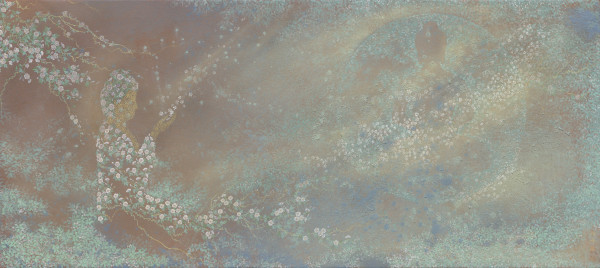Collect

Mind Creates All Dharmas
Glue painting
Size 134cm×60cm
Price Not Set | Contact us to inquire about artwork status and collection availability
Certificate
M2025GPG000003PA

Artist
Chen, Chun-Chi
Creation Year
2024
Condition Status
Well
Supplier
POST WINGS
Introduction
This piece is composed of natural elements that create a scene of the Buddha's realm. The most striking features are the two Buddha figures outlined by flowers and leaves, making the figures seem to emerge from nature, symbolizing the unity of the Dharma body with all beings. The background is dominated by soft reddish-brown tones, overlaid with white and green leaves, and dotted with blue spots, creating a dreamy and tranquil atmosphere; scattered white flowers and vibrant green leaves enhance the fresh vitality.
The image is divided into left and right by an invisible central axis. The right Buddha is seated in a half-profile, depicted with golden lines outlining its face and hands, while its body is formed of flowers. The right hand holds a white flower, echoing the phrase "smiling with a flower in hand," symbolizing "whatever is observed arises from the mind." The radiance from its palm extends to the left Buddha figure.
The left Buddha sits gracefully in a green circular light, its outline transparent and void, surrounded by a haze of light, symbolizing the formless and omnipresent nature of the Dharma body. White flowers fall gently around the circular light, adding an element of tranquility and liveliness to the scene.
The background features a flowing interplay of golden light and gold powder, resonating with the "Buddha light shining everywhere" from the Avatamsaka Sutra, symbolizing wisdom, compassion, and the infinite realm of Dharma. The flowers, leaves, light, and Buddha figures harmonize, presenting the state of "one is all, and all is one" and the idea of "nothing obstructs anything."
Ultimately, the work quietly reminds viewers with its luminous stillness: all phenomena arise from the mind; if the mind is pure, the realm of Dharma will manifest.
The image is divided into left and right by an invisible central axis. The right Buddha is seated in a half-profile, depicted with golden lines outlining its face and hands, while its body is formed of flowers. The right hand holds a white flower, echoing the phrase "smiling with a flower in hand," symbolizing "whatever is observed arises from the mind." The radiance from its palm extends to the left Buddha figure.
The left Buddha sits gracefully in a green circular light, its outline transparent and void, surrounded by a haze of light, symbolizing the formless and omnipresent nature of the Dharma body. White flowers fall gently around the circular light, adding an element of tranquility and liveliness to the scene.
The background features a flowing interplay of golden light and gold powder, resonating with the "Buddha light shining everywhere" from the Avatamsaka Sutra, symbolizing wisdom, compassion, and the infinite realm of Dharma. The flowers, leaves, light, and Buddha figures harmonize, presenting the state of "one is all, and all is one" and the idea of "nothing obstructs anything."
Ultimately, the work quietly reminds viewers with its luminous stillness: all phenomena arise from the mind; if the mind is pure, the realm of Dharma will manifest.
Video Intro
None
Exhibition Resume